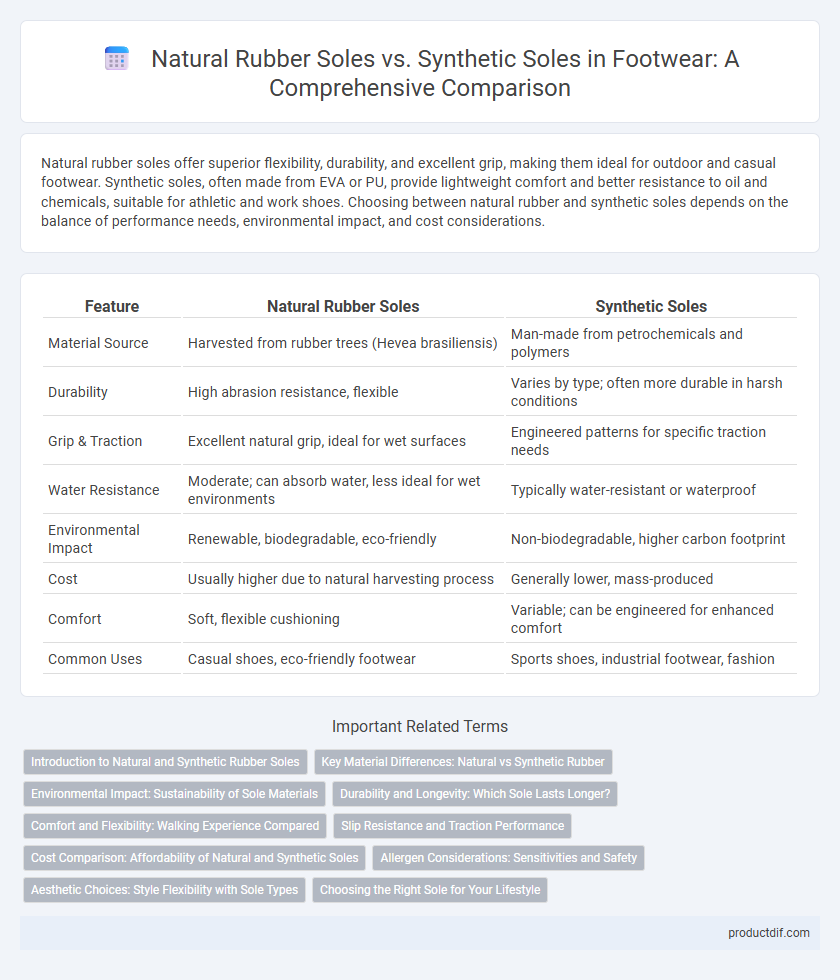Natural rubber soles offer superior flexibility, durability, and excellent grip, making them ideal for outdoor and casual footwear. Synthetic soles, often made from EVA or PU, provide lightweight comfort and better resistance to oil and chemicals, suitable for athletic and work shoes. Choosing between natural rubber and synthetic soles depends on the balance of performance needs, environmental impact, and cost considerations.
Table of Comparison
| Feature | Natural Rubber Soles | Synthetic Soles |
|---|---|---|
| Material Source | Harvested from rubber trees (Hevea brasiliensis) | Man-made from petrochemicals and polymers |
| Durability | High abrasion resistance, flexible | Varies by type; often more durable in harsh conditions |
| Grip & Traction | Excellent natural grip, ideal for wet surfaces | Engineered patterns for specific traction needs |
| Water Resistance | Moderate; can absorb water, less ideal for wet environments | Typically water-resistant or waterproof |
| Environmental Impact | Renewable, biodegradable, eco-friendly | Non-biodegradable, higher carbon footprint |
| Cost | Usually higher due to natural harvesting process | Generally lower, mass-produced |
| Comfort | Soft, flexible cushioning | Variable; can be engineered for enhanced comfort |
| Common Uses | Casual shoes, eco-friendly footwear | Sports shoes, industrial footwear, fashion |
Introduction to Natural and Synthetic Rubber Soles
Natural rubber soles, derived from latex harvested from rubber trees, offer superior elasticity, resilience, and biodegradability, making them an eco-friendly choice for footwear. Synthetic rubber soles, produced through chemical processes using petroleum-based materials, provide enhanced durability, resistance to abrasion, and consistent performance under various conditions. Both sole types influence shoe comfort, traction, and lifespan, with natural rubber excelling in flexibility and synthetic rubber favored for toughness.
Key Material Differences: Natural vs Synthetic Rubber
Natural rubber soles are derived from latex sap harvested from rubber trees, offering high elasticity, excellent grip, and biodegradability, making them environmentally friendly. Synthetic rubber soles, made from petroleum-based polymers like styrene-butadiene or neoprene, provide superior abrasion resistance, chemical stability, and durability in extreme temperatures. The choice between natural and synthetic rubber soles hinges on factors such as wear resistance, flexibility, environmental impact, and specific use conditions in footwear applications.
Environmental Impact: Sustainability of Sole Materials
Natural rubber soles offer superior sustainability due to their biodegradability and renewable sourcing from rubber trees, significantly reducing environmental footprint compared to synthetic soles derived from petroleum-based products. Synthetic soles often contribute to microplastic pollution and have a higher carbon footprint throughout their production and disposal processes. Choosing footwear with natural rubber soles supports eco-friendly practices by minimizing plastic waste and promoting the use of renewable materials.
Durability and Longevity: Which Sole Lasts Longer?
Natural rubber soles offer superior durability due to their excellent abrasion resistance and flexibility, making them ideal for extended wear in varied conditions. Synthetic soles, often made from materials like EVA or polyurethane, provide good shock absorption but tend to degrade faster under intense use and exposure to elements. Studies indicate that natural rubber soles generally last longer, maintaining structural integrity and traction over time compared to most synthetic alternatives.
Comfort and Flexibility: Walking Experience Compared
Natural rubber soles provide superior comfort and flexibility due to their excellent elasticity and shock absorption, enhancing the overall walking experience by reducing foot fatigue. Synthetic soles, while often lighter and more durable, may lack the same level of natural cushioning and pliability, potentially compromising comfort during extended wear. Choosing natural rubber soles benefits those seeking a soft, adaptive feel, particularly for activities involving prolonged walking or standing.
Slip Resistance and Traction Performance
Natural rubber soles exhibit superior slip resistance and traction performance due to their inherent elasticity and high friction coefficient, making them ideal for wet and uneven surfaces. Synthetic soles, often made from polyurethane or EVA, can be engineered for enhanced durability and specific grip patterns but generally offer less natural grip compared to pure rubber. Footwear with natural rubber soles is preferred in environments demanding reliable slip prevention and consistent traction.
Cost Comparison: Affordability of Natural and Synthetic Soles
Natural rubber soles generally come at a higher production cost due to the harvesting and processing of latex from rubber trees, making them less affordable compared to synthetic soles. Synthetic soles, typically made from materials like EVA or polyurethane, offer a cost-effective alternative with lower manufacturing expenses and consistent quality. Budget-conscious consumers often prefer synthetic soles for their affordability without sacrificing durability or comfort in everyday footwear.
Allergen Considerations: Sensitivities and Safety
Natural rubber soles contain latex proteins that can trigger allergic reactions in sensitive individuals, making them less suitable for those with latex allergies. Synthetic soles, typically made from materials like polyurethane or ethylene vinyl acetate, offer hypoallergenic alternatives by eliminating natural latex components. Choosing synthetic soles enhances safety for allergy-prone consumers, reducing the risk of skin irritation and respiratory issues associated with natural rubber exposure.
Aesthetic Choices: Style Flexibility with Sole Types
Natural rubber soles offer a classic, organic look that complements casual and eco-friendly footwear styles, enhancing earthy tones and textures. Synthetic soles provide greater design flexibility, allowing for vibrant colors, complex patterns, and varied textures that cater to modern, fashion-forward trends. Choosing between natural and synthetic soles can significantly influence the shoe's overall aesthetic, aligning with either traditional craftsmanship or innovative, bold style expressions.
Choosing the Right Sole for Your Lifestyle
Natural rubber soles offer superior elasticity, durability, and excellent grip on wet surfaces, making them ideal for outdoor activities and rugged terrains. Synthetic soles provide enhanced lightweight comfort, resistance to oil and chemicals, and greater design versatility, suited for urban use and fashion-forward footwear. Selecting between natural and synthetic soles depends on lifestyle needs such as durability, traction requirements, and environmental exposure.
Natural rubber soles vs Synthetic soles Infographic

 productdif.com
productdif.com